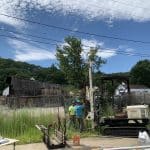Environmental investigation services to evaluate the nature and extent of PFAS contamination resulting from long-time training practices using Class B Aqueous Film Forming Foam.
The Site is a 4.4-acre parcel located at 59 West Bow Street in Franklin, New Hampshire. The Site contains several municipal buildings, including the Fire Station, Firefighter’s Museum, Public Works facility, and smaller ancillary buildings. The Site is located on the peninsula formed by a bend in the Winnipesaukee River, which is a tributary of the Merrimack River to the west. The Site was used from the 1890s to the mid-1930s for the manufacture of heating and lighting gas. From the 1940s until 1969, a natural gas/propane pump station was located at the facility. The existing fire station building was constructed in 1970.
The Franklin Fire Department (FFD) began using AFFF foam for fire suppression around 1973 or 1974. When performing training or maintenance with this apparatus, unmetered amounts of water and AFFF foam would be discharged, typically in the rear of the fire station in the designated Foam Training Area. The runoff from this operation flowed toward local storm drains and unpaved infiltration areas. Routine groundwater sampling for former MGP impacts at the Site revealed the presence of PFAS at concentrations exceeding AGQS. Training was discontinued in 2018 following discovery of PFAS in groundwater beneath the Site.
Nobis completed a Focused Site Investigation on behalf of the City of Franklin. Investigation activities included: a review of Site history and practices relative to Class B AFFF use; installation of three monitoring wells to supplement the existing monitoring network; collection of soil, groundwater, and surface water samples for PFAS analyses; hydraulic conductivity testing; review of potential receptors in the vicinity of the Site; development of a conceptual site model and subsurface cross section; and regulatory reporting. Nobis worked closely with municipal officials and NHDES to prepare a Work Plan for the investigation that met the requirements of Env-Or 600.
challenges
- Development of the conceptual site model was complicated by the presence of multiple subsurface utilities, influence from the Winnipesaukee River, and transitional variation in the subsurface depositional environment.
- Budget limitations required sampling coordination with other environmental assessments ongoing in the vicinity to reduce costs.
solutions
- Use of existing monitoring wells from the MGP site as well as the abutting Ciao Pasta Brownfields site reduced the need for additional monitoring well installations.
- Groundwater sample collection related to the abutting Ciao Pasta Brownfields site included incorporation of PFAS analyses as part of the Brownfields assessment, saving a significant amount of money in laboratory analyses and labor for groundwater sample collection.
results
The results of the investigation indicated the presence of PFOS in groundwater in areas within the immediate vicinity and downgradient of the Foam Training Area. Samples collected from three side gradient locations reported concentrations of PFOA greater the than PFOS, suggesting the possibility that a separate source is impacting the groundwater at those locations. Soil in the immediate vicinity of the Foam Training Area also reported the presence of PFAS compounds, as well as surface water samples in the adjacent Winnipesaukee River.
The overall groundwater contaminant plume extends approximately 800 feet south of the Fire Department with groundwater flow inferred towards the downstream side of the Winnipesaukee River. No drinking water wells or other sensitive receptors were identified during the investigation and the site is being managed currently through ongoing groundwater monitoring.



